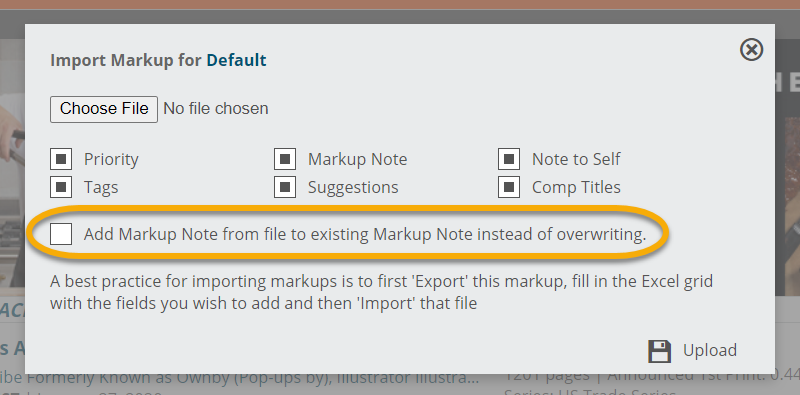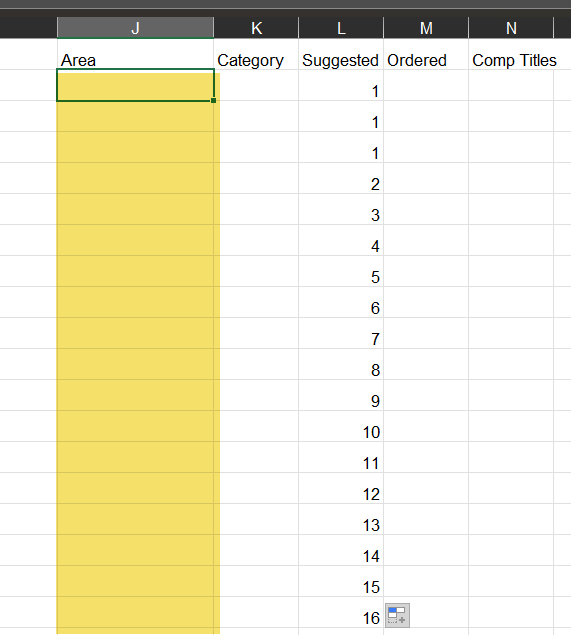This is a feature that allows you to work on a markup “offline” in Excel. The original purpose was to provide reps with a way to work on markups when not connected to the internet. The idea is that you export a markup from Edelweiss, work on the Excel file to add or modify notes, tags, priorities, and suggestions. Then, when you are back online, re-import the same Excel file into Edelweiss to update your markup. This feature has enabled a few other tricks as well. For example:
- You can share your Excel files with other reps, and they can import your notes. A word of caution: If you do import another rep’s notes, tags, or priorities, they will override any notes, tags, or priorities you already have set for that markup. If you do NOT want to override your current values, create a new markup before importing! Note the option to select “Add Markup Note from file to existing Markup Note instead of overwriting” to simply append your existing markup notes rather than replacing them, but this tool works for notes only.
- You can make Suggestions for one account and import the same numbers as Suggestions for another account.
- You can annotate one catalog, and import your notes into another catalog or collection that includes some of the same titles.
- If you want to quickly apply the same value (e.g., ‘Skip’ for priority) to a large number of titles, you can do so in Excel and re-import to your markup.
- You can import data to your markup from an entirely different source if you first format it into the right Excel format. See below for formatting details.
- Some reps use this as an offline order form. The exported file exports all titles listed in the catalog or collection, and if you have selected a store name at the top of the page before exporting, your specific order suggestions and any store’s order quantities on open orders will be exported, too. If need be, you can save this file and even print it if you’d like, and use this spreadsheet as an order form… (Note that order quantities cannot be imported. This is just a way to generate a form.)
To start, click on Export Markup in the Markup Menu icon at the top of a catalog page.
An Excel file will download to your computer with the ISBN and description for each title in the given catalog, along with a column for each editable field in a markup. You can edit these directly in the spreadsheet.
Once you’ve made your changes and saved the spreadsheet to your computer, or if another rep has sent you their markup file to use, click the Import Markup option in the Markup Menu to import the markups back into the system. The Import Markup window will include checkboxes for you to indicate which elements you’d like to import: Markup Note, Priority, Suggestions, Comp Titles, Note to Self, or Tags. Remember to check at least one of those boxes. Edelweiss will display a confirmation message when the file has been imported successfully, and then will refresh the page to show the updates you’ve imported.
If you’d like to simply add to your existing Markup Notes, you can use the Add Markup Note from file to existing Markup Note instead of overwriting tool, shown below. With this option, the markup note text included in a file will simply be added to your markup notes rather than completely overwriting any existing notes. Note that this option currently only impacts markup notes — tags, personal notes, and other markup elements cannot be appended using this method. More on using this feature here!
Tips & FAQs on importing markups:
- Fields that can be edited and imported via spreadsheet include Priority, Markup Note, Tags, Note to Self, Suggestions, and Comp Titles only. All other fields are just for your reference, and even if the contents are deleted or changed, there will be no impact on what is imported.
- Column Names: You must keep the names of the header columns since this is how Edelweiss recognizes which content should go where!
- Sorting: You can re-sort titles in Excel (just don’t include the headers when you sort to make sure they stay at the top).
- Skipping titles: If you’d like, you can remove rows from your Excel file completely if there are titles in your markups you don’t want to update with the data in the spreadsheet. For example, if the spreadsheet came from a colleague and you want to protect some titles in your markup from being updated at all, you could remove the rows with the ISBNs you don’t want to update.
- Export/Import is Markup-specific: The updates you make in an Excel file will apply to whichever markup you have selected in the markup toolbar at the top of the page. You can still create a new markup that includes none of these notes, or create a new markup for the catalog that copies over all of the notes from the first markup. If you have not created a markup, your import will be loaded into the markup called “Default.” Also note that this process will look at the ISBNs in the file, and only add elements to your markup for matching ISBNs; no new titles will be added to a markup. And, if you import a markup into a catalog other than the one it came from originally, it will just match by ISBN – for example, you could use a markup from an imprint-specific catalog, and import it into a ‘combined’ or ‘Omni’ catalog that contains the same titles. Only the titles in the spreadsheet will update your markup.
- Create a backup if unsure: If you are importing another rep’s markup and are concerned about overriding your own data, we recommend first exporting your markup to your own Excel file. In the worst-case scenario, you can always re-import the file to set the markup back to the way you had it originally.
Editing Guidelines:
- ISBN: ISBNs should not be changed as they are the reference key that allows the import to work properly.
- Priority: You can adjust Priority here – if this field is left blank, the Priority will import as “Not Set.” Otherwise, the field must be set to one of the following: High, Featured, Highlighted, or Low.
- Markup Note: You can edit or add notes here and they will be imported into the markup if you check the box for ‘Markup Note’ as you part of your import. The maximum length for a markup note is 5,000 characters. Keep in mind that the note in your Excel file will always override any existing note for the same title in the markup you are importing to unless you check the option to “Add Markup Note from file to existing Markup Note instead of overwriting.” …Even if your note is blank in the Excel file!
- Tags: Tags you’ve already added to ISBNs as part of your markup will be exported, and you can add new tags here as well. If you are including more than one tag in your Excel file for the same title, separate them with commas to ensure that they are imported as separate tags.
- Area: This is the spot for store name and needs to stay the same to import successfully. If, however, you want to copy existing suggested orders and upload them for another store, you’ll want to make sure this column is there, but blank like so:
Note: If the account you’re viewing has multiple locations, each location will have its own line in your spreadsheet. To produce a markup export with just one line for each title, view a single location account before exporting your markup.
- Suggested: This is the area for Suggestions. You can enter them here, and they will be imported when you import the Excel file back into Edelweiss – assuming you first select an account from the markup toolbar. Note that if you want to import Suggestions for a different account, you’ll want to delete entries in the “Area” column in your Excel file to clear it out, as mentioned above. You can import Suggestions only by unchecking the boxes next to everything except Suggestions upon import.
Other Fields:
- Title: Titles are there for your reference; edits will not change the markup when imported.
- Imprint: The imprint column is there to help you quickly find titles belonging to specific imprints while working in your Excel file.
- Category: This represents the POS category a store has applied to this item if they ordered it.
- Ordered: If the account has already made orders, those numbers will be here. Any edits you make here will NOT be imported since only the accounts can edit their actual order quantity. These are simply for your reference.
- Comparable: This area will include all Highlighted comparable titles. See details about comparable titles and how to highlight them here.





